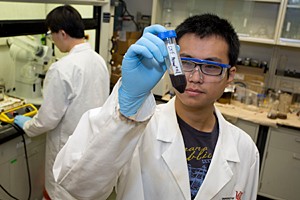
Researchers Read the Coffee Grounds and Find a Promising Energy Resource For the Future
For many of us, its the fuel that wakes us up and gets us started on our day. Now, University of Cincinnati researchers are discovering that an ingredient in our old coffee grounds might someday serve as a cheaper, cleaner fuel for our cars, furnaces and other energy sources.
Yang Liu, a graduate student in environmental engineering in UCs College of Engineering and Applied Science (CEAS), presents a summary of early-but-promising discoveries on his teams research at the American Chemical Societys (ACS) 246th National Meeting & Exposition this week in Indianapolis.
Liu and fellow researchers Qingshi Tu, a UC doctoral student in environmental engineering, and Mingming Lu, a UC associate professor of environmental engineering, used a three-pronged approach to converting waste coffee grounds into energy sources including biodiesel and activated carbon by:
- Extracting oil from the waste.
- Drying the waste coffee grounds after oil removal to filter impurities in biodiesel production.
- Burning what was left as an alternative energy source for electricity, similar to using biomass.
The researchers launched the project in 2010, gathering waste coffee grounds in a five-gallon bucket from a Starbucks store on UCs campus. After collection, they removed the oil from the waste coffee grounds and converted triglycerides (oil) into biodiesel and the byproduct, glycerin. The coffee grounds were then dried and used to purify the biodiesel they derived from the waste coffee grounds.
The preliminary results showed that the oil content in the waste coffee grounds was between 8.37-19.63 percent, and biodiesel made from coffee oil meets the ASTM International D6751 standard. The efficiency of using the waste coffee grounds as a purification material to remove the impurities in crude biodiesel, such as methanol and residual glycerin, was slightly lower compared with commercial purification products. However, the researchers report that results still indicate a promising alternative, considering the cost of purification products. Future research will continue to focus on improving the purification efficiency of waste coffee grounds-derived activated carbon.
Compared with petroleum diesel, the cleaner-burning biodiesel reduces the emission of carbon monoxide, hydrocarbons and particulate matters (PM).
Waste coffee grounds that result from brewing one of the worlds most popular beverages is estimated to result in more than one million tons per year in the U.S. alone, with the majority of that waste getting dumped into landfills.

Qingshi Tu, Mingming Lu and Yang Liu
The researchers say the method theyre exploring to produce biodiesel would not only open landfill space, but it also holds promise in creating biodiesel from a natural product thats not also in high demand as a food source, such as corn and soybean crops that are used to manufacture biodiesel.
The project was among four proposals selected for a $500 grant last spring from the
an enterprise led by UC Student Government and the UC student chapter of the Association for Computing Machinery to share ideas and encourage innovation in campus life.
Related Stories
UC’s Ground Floor Makerspace births combat robots
April 17, 2024
In the heart of UC's 1819 Innovation Hub lies the Ground Floor Makerspace, an advanced and active hub of ingenuity where students, faculty and the community converge to bring their ideas to life. This includes being the birthplace of robots much like miniature race cars, combating fender to fender in an enclosed boxing ring. Combat robots like UC's Maximizer will again be fighting for first place in the National Havoc Robot League (NHRL) competition, slated for April 20.
UC researchers develop new CPAP device
April 17, 2024
Researchers at the University of Cincinnati are developing a VortexPAP machine that takes advantage of vortex airflow technology. A preliminary clinical study with current CPAP users demonstrated that the VortexPAP can deliver the pressure levels that are used in the subjects’ CPAP therapy, but the mask is more comfortable to wear. It has a minimalistic design that is less intrusive and barely touches the patient’s face.
UC architectural engineering alumna inspires high school students
April 16, 2024
University of Cincinnati alumna Emma Wilhelmus fell in love with engineering when she was in ninth grade. After taking drafting, architecture and engineering courses in high school, she set out to major in architectural engineering in college. Now, she is an engineering teacher at a local high school and hopes to inspire students.
